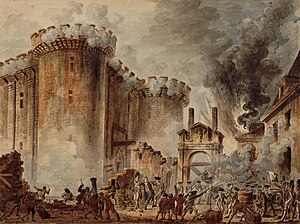
Back Presa d'a Bastilla AN اقتحام سجن الباستيل Arabic Toma de la Bastilla AST Bastiliyanın alınması Azerbaijani باستیلیانین آلینماسی AZB Узяцце Бастыліі Byelorussian Превземане на Бастилията Bulgarian বাস্তিলের বিক্ষোভ Bengali/Bangla Kemeridigezh ar Bastille Breton Presa de la Bastilla Catalan
| Storming of the Bastille | |||||||
|---|---|---|---|---|---|---|---|
| Part of the French Revolution | |||||||
 Storming of The Bastille, Jean-Pierre Houël | |||||||
| |||||||
| Belligerents | |||||||
|
French Guards mutineers |
| ||||||
| Commanders and leaders | |||||||
|
Pierre Hulin*[1] Stanislas Maillard Jacob Job Élie[2] |
| ||||||
| Strength | |||||||
|
114 soldiers
| ||||||
| Casualties and losses | |||||||
|
| ||||||
The Storming of the Bastille (French: Prise de la Bastille [pʁiz də la bastij]) occurred in Paris, France, on 14 July 1789, when revolutionary insurgents attempted to storm and seize control of the medieval armoury, fortress and political prison known as the Bastille. After four hours of fighting and 94 deaths, the insurgents were able to enter the Bastille. The governor de Launay and several members of the garrison were killed after surrender. The Bastille then represented royal authority in the centre of Paris. The prison contained only seven inmates at the time of its storming and was already scheduled for demolition, but was seen by the revolutionaries as a symbol of the monarchy's abuse of power. Its fall was the flashpoint of the French Revolution.
In France, 14 July is a national holiday called Fête nationale française which commemorates both the anniversary of the storming of the Bastille and the Fête de la Fédération which occurred on its first anniversary in 1790. In English this holiday is commonly referred to as Bastille Day.
- ^ Lüsebrink, Hans-Jürgen; Reichardt, Rolf; Schürer, Norbert (1997). The Bastille. Duke University Press. p. 43. ISBN 978-0-8223-1894-1.
- ^ Schama 1989, p. 402.